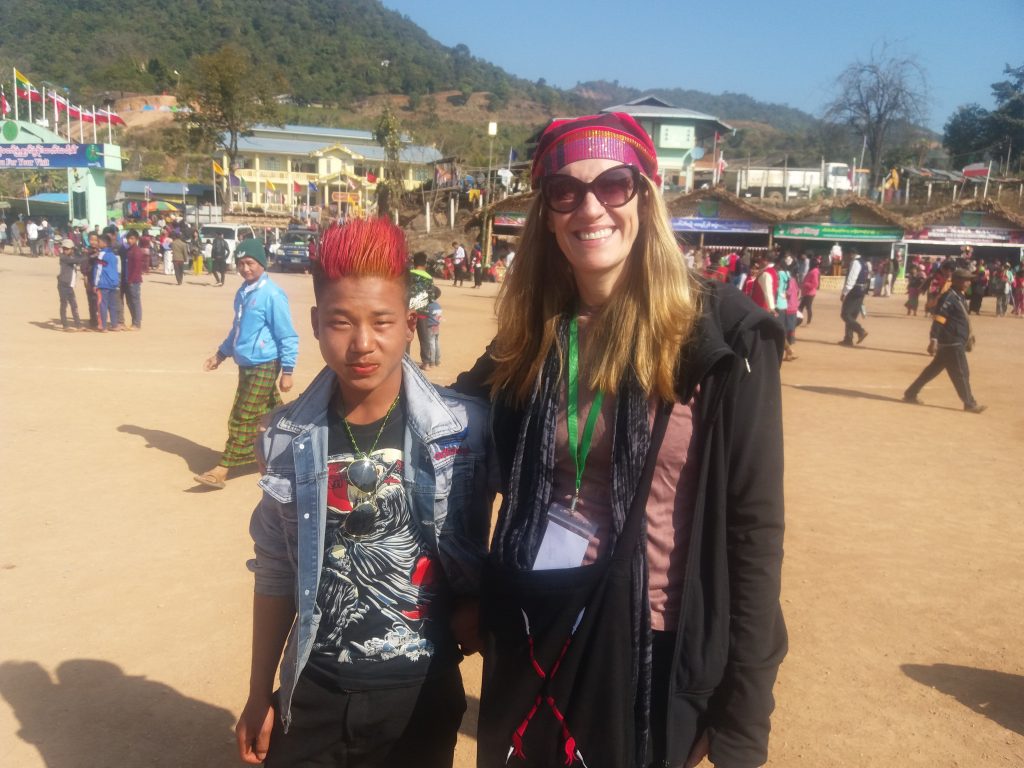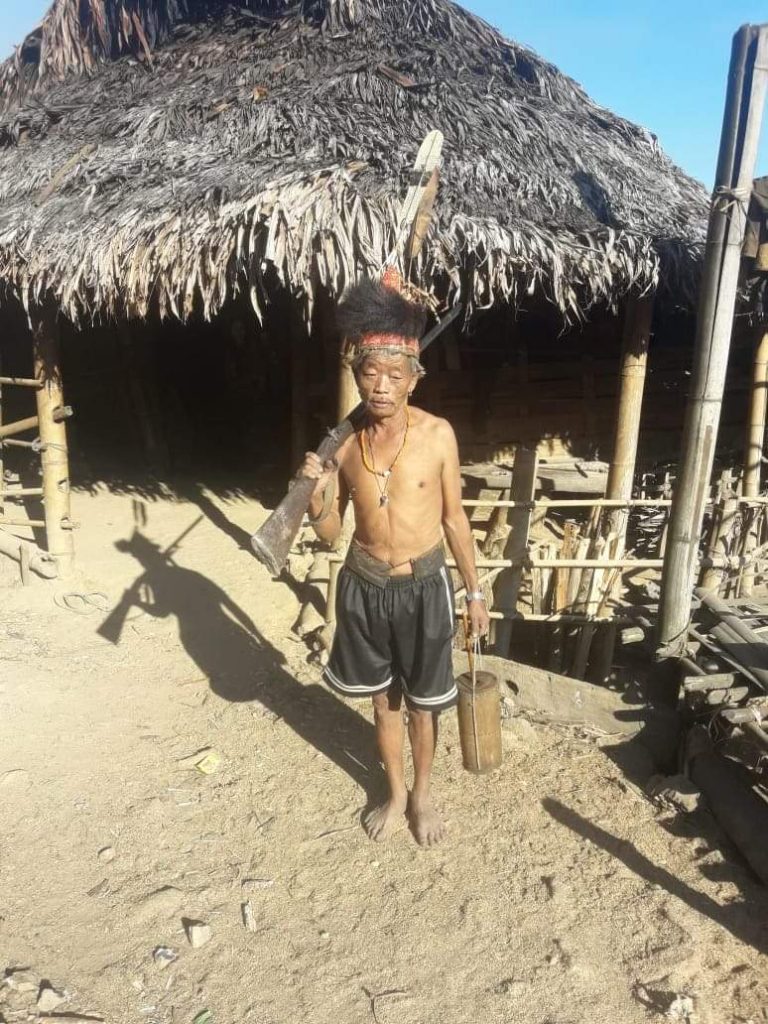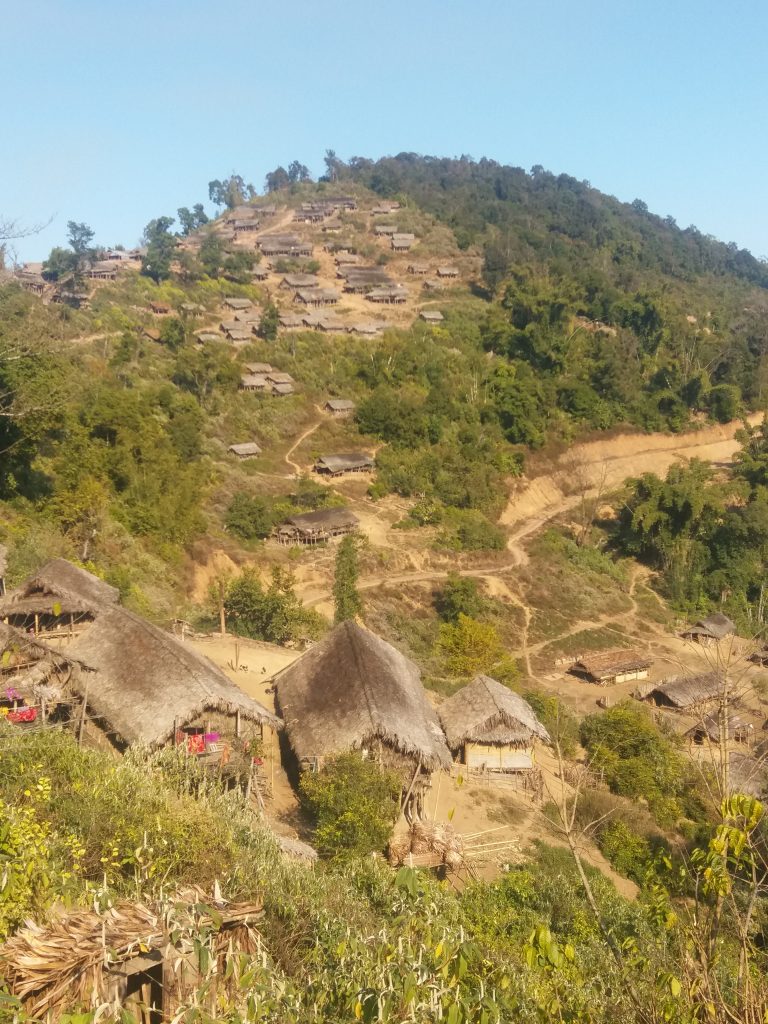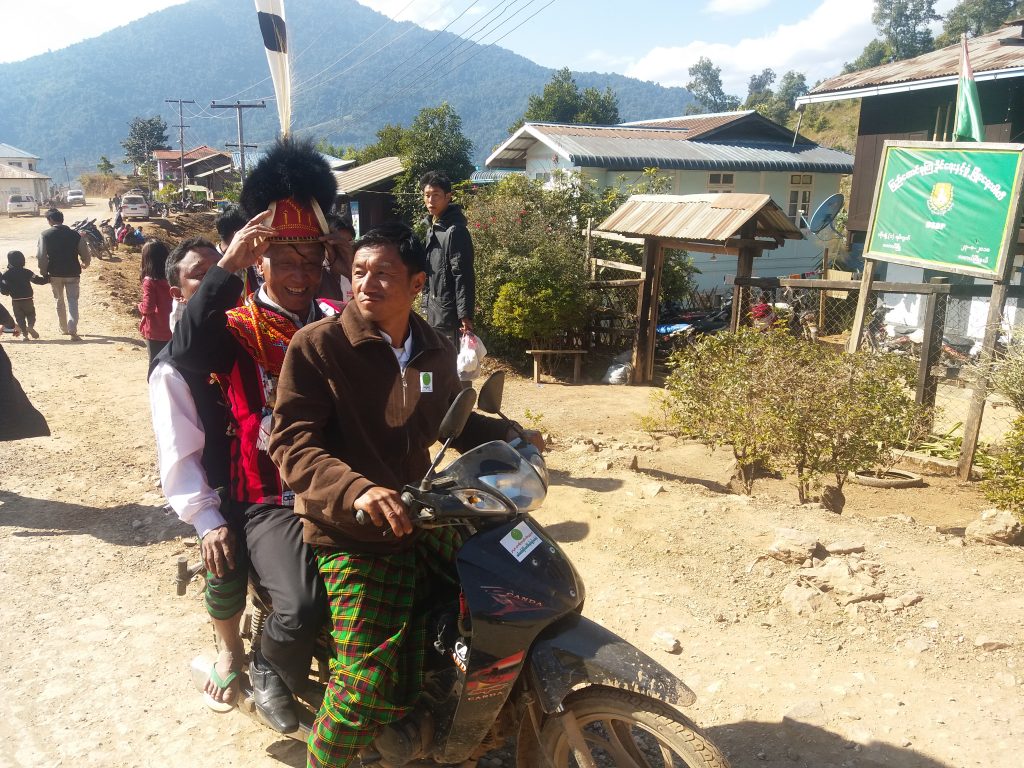AS the chorus of the Para tribal women reached an eerie crescendo I could feel each hair on the back of my neck shiver with anticipation. We were there to bear witness to the ‘Festival Pole Erection Ceremony’ that heralded the Nagaland New Year celebrations and it was indeed spectacular. The welcome line was over 800 meters long of the different Naga tribes in full regalia – singing and chanting their calls to battle. A cultural kaleidoscope of colours, feathers, bones and spears as the tribes of warriors danced and lept with bravado into the grounds before us.
As luck transpired the towering bamboo ‘Festival Pole – hoisted into the air on the shoulders of the tribesmen and paraded across the grounds – did not break so the real carousing could begin. Given the UN described the Naga townships as “the poorest, most isolated and least developed in Myanmar” I was relieved not to bear witness to the heralding of further despair.

After many years of yearning to explore the far reaches of Myanmar – west of the mighty Chindwin – north of Sagaing – my wish was finally granted in the form of a group of intrepid explorers seeking more than just a cursory look into the Naga New Year Festival. Don’t get me wrong – the New Year Festival is totally amazing. I am so grateful that this year it was in Lahe, as they allowed foreigners to attend (the Festival rotates, and sometimes in the other 2 main townships foreigners are often barred from entry). But I didn’t want to travel all that way and not experience the remote Naga Hills and her fierce warrior tribes of legend – sporting chin tattoos and wielding spears – who fought alongside the Allied Forces in both World Wars and collected their enemies heads.
It is certainly a land of many contrasts and transitions. Lahe is a bustling market town with occasional bursts of wifi and young lads sporting jeans alongside men in traditional dress. I met a young student named Helen with flawless English, who traversed the countryside and crossed the border into India for her schooling. She was taking her auntie and cousin to the festival. They were particularly excited as a young Naga singer who had made it big on Myanmar Idol was going to perform that evening. There were punk rockers, heavy metal heads, teenage biker gangs (well, more like mopeds), and a whiff of defiance in the air as they revved on by. I lost track of how many selfies I appear in with rebellious teenagers rocking at the bandstand, full of khongyee courage and youthful pride – celebrating all things Naga.

Festival goers in Lehe 
Naga Calling 
Outside Lehe
The next morning we traveled on and off the narrow, spiraling trail toward Sandong village – cold, harsh and dusty – where we could peer out across the remote landscape and wonder at the expanse of bamboo huts seemingly sprouting up from nowhere. Long generational houses dotting the neighbouring mountain. Only the very old, very sick, and very small had been left in the village during the time of the Festival – and mothers with too many young to walk the distance (20km of steep and windy road that took us many hours to traverse in a 4WD let alone by foot). We had been instructed by the company who granted us access into the Festival that we should bring some kind of gift of thanks for the village ‘headman’ (note: this normally ended up being a pastor as many villages are Christian). Somehow this was horribly translated into pre-wrapped sweets for the children – individually wrapped in plastic no less. There followed a flurry of activity as we realised too late that there was going to be no such thing as a garbage disposal and that we must capture the flying wrappers before the wind carried them away. Subsequent village visits we made sure we turned up with 60kg bags of rice for the pastor to distribute amongst her congregation by way of thanks for allowing us to visit (and firm words to the tour operators that there would be no junk food for the children on our watch). Had we thought in advance, the bags of oranges in Hkamti would have likely provided all the sweet a child needed.

Sandong Village 
Collecting firewood

Generational bamboo houses
We were quite surprised by the disparity between the neighbouring villages separated by less than 20km of road. The very nascent signs of growth compared to the first, with bore water wells and solar panels and fences for the black wiry pigs that snuffed and snorted around. We were told that this village was a recipient of aid, whereas others had been warned by their forefathers against ‘those bearing gifts’. I spotted a sign for a community health clinic funded by Myanmar Action Network, a Myanmar based health NGO I was familiar with from travel to other rural villages. One of the nurses told me that there were children in the village that had been diagnosed with rickets – an easily preventable disease that left untreated has horrible, deforming consequences (kept at bay with a bit of Vitamin D and Calcium). As the children giggled at us from behind the bushes, I realised that they were too timid to come out into the open. Not necessarily a bad thing in my books.
It was in the village of Majang that we came across Hiroshi Iguchi film maker and recording engineer who was finishing a documentary on the iconic Naga Drums. Yoshi and Shizue the groovy Japanese couple traveling with us knew of his project and explained that he had lived in the village for a month to film. We were in awe of his dedication. The drums actually remain an integral part of village life to call the people together – though no longer to wage war. I hope to have the chance to show his film in Yangon when it is finished.

As we danced into the evening, and traversed the rugged terrain each morning we were attestant to that perpetual dance of past and future beliefs on its inevitable collision course with smart-phone reality. Was this a place suffering from years of neglect, or a people who wished to be fiercely Naga – the truth is likely to be found somewhere in the middle. But like all places I have seen in Myanmar it is a place of youth. Primarily youth. There is no stopping internet vloggers, emerging rappers and the ever enticing promise of stardom by any means. So we bore witness – as we all do – to a place in transition, supporting those that welcomed us to be there and celebrating alongside revellers and travellers alike.

So what now?
If you want to go whether you are going to climb Mount Saramati or Trek through villages make sure you have the right visas and permits. We used Mirandus Travel & Tour (but that was because of the Festival permits) E-mail: info@mirandustravel.com. It is crucial to have a local guide no matter what to help earn trust in the villages. We had Rupiuthong (from Makury Naga tribe) Thamanthi village. You can locate him as “Rupiuthong” on Messenger and by phone at +959 447 987117. Guides for the mountains can be found most easily at the village itself. The area is tribal so each village is separate and distinct and can be prone to turf wars that you are better to let sort themselves out clan-to-clan (eg Tankon Clan porters don’t necessarily have rights to the summit (which is given by the Makuri Naga clan)).
PLEASE – don’t bring junk-food gifts and don’t let your tour operators do it either. The best way to help the children of Naga villages beat Rickets is to donate money to the hardworking front line of Medical Action Myanmar (MAM). http://medicalactionmyanmar.com/ Currently, MAM is providing treatment with vitamin D tablets and Calcium tablets to a total of 330 patients. The signs and symptoms of most patients are improving. They also need physiotherapy or surgery for cases of severe deformity. Their team train field staff and patients in hygiene and nutrition. They are also providing malaria diagnosis and treatment of common illness in the communities (including malnutrition), and referral of TB to hospitals. DONATIONS ARE TAX DEDUCTIBLE FOR EUROPEANS AND NORTH AMERICANS. Contact Sieb Janssen, Resource Director, Medical Action Myanmar, E-mail: Sieb@mam.org.mm. or Hein Aung heinaung@mam.org.mm
Important last note: for those of us who don’t sleep through the night without a call to nature. At the time of writing this, there were very few rooms to stay that had indoor plumbing in Lahe. We had a home stay with a lovely family, but the trip to the long-drop was down 2 flights of stairs and 100 meters through very challenging terrain of chickens and ducks and dirt and rock. Even with a head lamp it was extremely challenging not to mention extremely cold! I highly recommend booking with Dr. Aung Myat Kyaw’s newly built lodge in Lahe called the Naga Hill Lodge if you want an indoor loo. People can call Ma Nan at +959428522231 or the office phone +951200883 for all the other arrangements. https://www.facebook.com/Naga-Hill-Lodge-102317694729548
And please don’t forget to take a trip on the mighty Chindwin. Don’t fall for the so-called government tourist orgnisers or “help desks” or you will be there all day in endless circular negotiations. Just walk down the bank and hail a boat, or jump on a river taxi if you have more time. The amazing bird life on the cliff’s is well worth seeing, as is the everyday life of those on the river. In Winter season, people farm on the riverbed where the water recedes. Good luck and stay curious!

Interesting Articles and curious facts about Naga:
